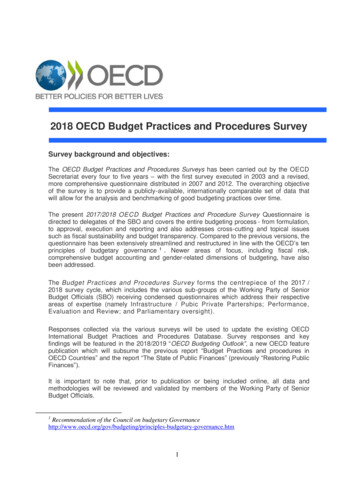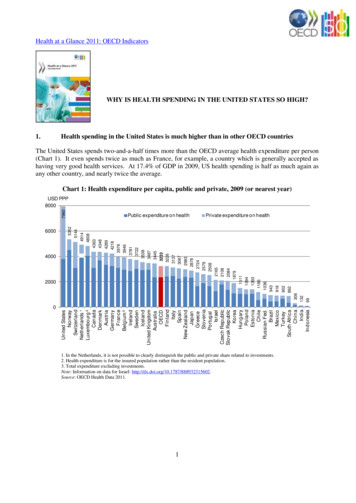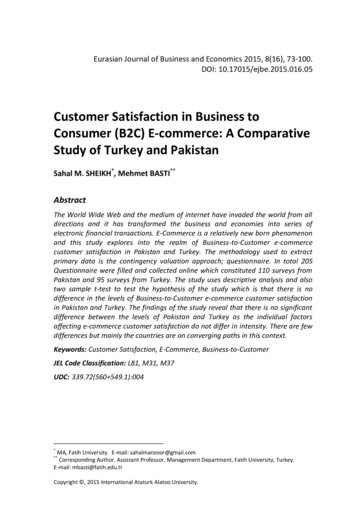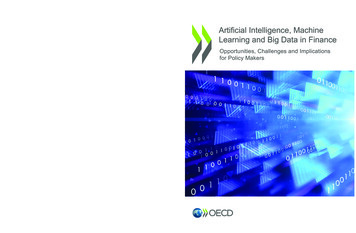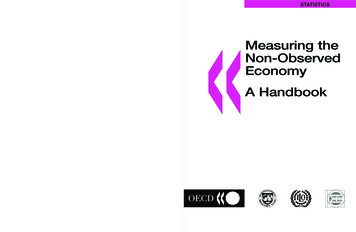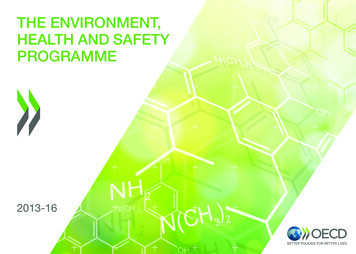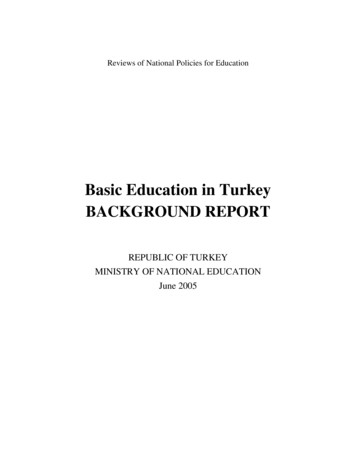
Transcription
«ORDER FORMHIGHLIGHTSI wish to order:OECD Science, Technology and Industry Outlook(92 2002 14 1 P) ISBN 92-64-19844-XPrice: 73 45US 73 8 450(Prof./Dr./M./Mrs)First NameSurnameOrganisationAddressTownPost/Zip CodeCountryTel.FaxE-mail ChequeOECD Science,Technology andIndustry Outlook Money Order (enclosed) Please charge my card Visa CardCard No. Mastercard/Eurocard AMEXCard Expiry DateSignatureWHERE TO ORDERCustomers in North AmericaOrders:OECD Washington Center2001 L Street N.W., Suite 650Washington, DC 20036-4922 USAToll free: 1 (800) 456-6323Fax: 1 (202) 785-0350General information:Tel.: 1 (202) 785-6323E-mail: washington.contact@oecd.orgInternet: www.oecdwash.orgCustomers in JapanOrders and Information:OECD Tokyo CentreLandic Akasaka Bldg.2-3-4 Akasaka, Minato-kuTokyo 107-0052, JapanTel.: 81 (3) 3586 2016Fax: 81 (3) 3584 7929E-mail: center@oecdtokyo.orgInternet: www.oecdtokyo.orgCustomers in MexicoOrders and Information:OECD Mexico CentreAv. Presidente Mazaryk 526Colonia: Polanco, C.P. 11560,Mexico, D.F.Tel.: 52 (52) 81 38 10Fax: 52 (52) 80 04 80E-mail: mexico.contact@oecd.orgInternet: rtn.net.mx/ocde/Customers in the rest of the worldOrders:OECD TURPINP.O.Box 22Blackhorse RoadLetchworth SG6 1YT EnglandTel: 44 1462 687552Fax: 44 1462 480947E-mail: books@Turpinltd.comInternet: www.oecd.org/bookshopGeneral InformationOECD2, rue André-Pascal75775 Paris Cedex 16, FranceTel: 33 1 45 24 81 67Fax: 33 1 45 24 19 50E-mail: sales@oecd.orgInternet: www.oecd.org/bookshopORGANISATION FOR ECONOMIC CO-OPERATION AND DEVELOPMENT2002
OECD, 2002. Software: 1987-1996, Acrobat is a trademark of ADOBE.All rights reserved. OECD grants you the right to use one copy of this Program for your personal use only. Unauthorised reproduction,lending, hiring, transmission or distribution of any data or software is prohibited. You must treat the Program and associated materialsand any elements thereof like any other copyrighted material.All requests should be made to:Head of Publications Service,OECD Publications Service,2, rue André-Pascal,75775 Paris Cedex 16, France.
HIGHLIGHTSScience, technology and innovation remain centralto economic growthDespite the economic slowdown that spread across the OECDarea in 2001, investment in and exploitation of knowledge remainkey drivers of innovation, economic performance and social wellbeing. Over the last decade, investments in knowledge – as measured by expenditures on research and development (R&D), highereducation, and information and communication technologies (ICTs) –grew more rapidly than gross fixed capital formation. Admittedly, thepace and depth of this transition has varied considerably, notably inregard to relative investments in R&D, higher education and software.Nevertheless, the general trend continues apace, as is clear from therising share of technology and knowledge-based industries in totalgross value added and employment in the OECD area.Increasing investmentsin knowledge remain a keydriver of economic performancein the OECD area The movement of OECD countries towards a knowledge-basedsociety is linked to the emergence of a more networked economy,which has helped to improve productivity, chiefly through the generation, diffusion and use of information. ICTs in particular played akey role in the increase in labour productivity in several OECDcountries in the 1990s and, although investment in ICTs wasseverely affected, it is now beginning to recover. The widespreadadoption of ICTs has led to new modes of work organisation whichenhance the benefits these technologies offer for disseminating andusing information. In several OECD countries in the 1990s, ICTsplayed a key role in boosting labour productivity through additionalcapital formation and the acceleration of multifactor productivitygrowth. and are associated withthe emergence of a morenetworked economy.The shift towards a more networked economy has been accompanied by – and facilitated – tighter integration of the knowledgeeconomy and an expansion of market and non-market knowledgetransactions. The production and application of scientific and technological knowledge has become a more collective effort, linking theactivities of industry, academia, and government. Formal and informal co-operation among institutions has become crucial for reapingthe full benefits of knowledge creation and fostering the development of new technological innovations. Virtually all forms of collaboration, including co-operative research, public/private partnerships,international and domestic strategic alliances, and foreign directinvestment, show signs of increasing.Knowledge creation andapplication has becomemore collaborative. OECD 20021
OECD Science, Technology and Industry Outlook 2002R&D spending has increased,but the gap separating Europefrom the United States andJapan is widening.Figure 1.OECD countries as a whole are devoting more resources toR&D. After stagnating in the first part of the 1990s, OECD-wide R&Dinvestments grew in real terms from USD 416 billion to USD 552 billion between 1994 and 2000, and R&D intensity climbed from 2.04%to 2.24% of GDP. Similar patterns were followed in all major OECDregions, although significant differences remain at country andregional levels, and existing gaps have widened. The EuropeanUnion as a whole lagged behind the United States and Japan, withan R&D intensity of 1.9% in 2000 compared to 2.7% in the UnitedStates and almost 3.0% in Japan. Countries that posted the largestpercentage point gains in R&D intensity tended to be those withalready high levels of R&D, such as Finland and Sweden, furtherwidening the gap between them and less R&D-intensive countries,such as Poland, Hungary and the Slovak Republic.GERD as a percentage of GDP, 1994 and .01.00.50.50SwedFi ennlandUni Jate padSt natesSw Koritz eaerG laner dmaI nyTo celta anlO dECFr DaD nceeN nmethe arkrlanBe dslgiuEumro Canpe aan daUnUnioite Au nstdKi riangdAu omstraCze N liach orwR ayepubIre liclandItalySpH ainungPo aryrtugSlov P alak olaRe ndpubG licreecTu erkey01. Or nearest available years.Source: OECD, MSTI database, May 2002.2Industry accounted for nearlyall of the growth in R&Dduring the 1990s Growth in R&D expenditures during the 1990s resulted almostexclusively from increases in industry-financed R&D, which grew bymore than 50% in real terms between 1990 and 2000. Governmentfunded R&D grew by only 8.3% during this period. As a result, theshare of total R&D financed by industry reached 63.9% in 2000, considerably above its level of 57.5% in 1990, while the government’sshare declined from 39.6% to 28.9%. and is financing more R&Din public researhorganisations.Industry is increasingly funding R&D performed by public sector organisations. Industry funding accounted for 6.1% of total R&Dfunding for universities and 4.4% of total R&D funding for other public research organisations (PROs) in 2000, compared to less than 3% OECD 2002
Highlightsand 2%, respectively, in 1981. Combined with reduced governmentfunding of business-performed R&D, increased industry funding ofpublic research has meant that the share of R&D performed by thebusiness sector remained stable in the 1990s (69.7% in 2000 against69.3% in 1990).International co-operation in S&T is also increasing: the percentage of scientific publications with a foreign co-author reached31.3% in the OECD area in 1999 against 14.3% in 1986. Over the sameperiod, the share of US patents with a foreign co-inventor rose from2.6% to 7%. R&D expenditures by foreign affiliates also increased,both in real terms and as a share of business R&D in many of theOECD countries, including Canada, France, Ireland, Japan, Sweden,the United Kingdom and United States.Science and technologyare becoming moreinternationalised.The stock of researchers expanded in almost all OECD countries in the 1990s, with total researchers per thousand in the labourforce reaching 6.2 in 2000 compared to 5.6 in 1990. Significant disparities remain, however, among the major OECD regions, with theEU as a whole lagging well behind the United States and Japan.Attempts to boost R&D funding and improve its effectiveness needto be accompanied by commensurate efforts to expand andstrengthen the science and technology workforce. Growing emphasis is being placed on the productivity-enhancing role of humancapital and higher education systems, which are central to the creation, dissemination and utilisation of S&T knowledge.The efficiency of R&Dinvestment is predicated uponthe availability of highlyskilled human resources.Closely related to the demand for S&T workers is the increasinginternational mobility of students, researchers and other highlyskilled personnel, both within and to the OECD area. Driven bydemand for ICT and other speciality workers, the internationalisation of higher education and research, the migration of scientific talent has renewed concerns about a “brain drain”. Ensuring that suchmobility results in positive gains for sending and receiving countries – i.e. by promoting the circulation of workers – has become anarea of growing policy interest.Increased mobility of S&Tworkers raises concerns abouta “brain drain”.Governments are adapting policy frameworks to enhancethe contribution of science, technology and innovationto economic growthOECD governments are paying more attention to the contribution of science and innovation to economic growth and have introduced a variety of new initiatives and reforms. Several countries,including Australia, Canada, Hungary, Ireland, Korea and Spain,introduced comprehensive policy frameworks to guide developments in science, technology and innovation. In a number of countries, government institutions and agencies have been restructuredin an attempt to improve the governance of innovation systems,and policy evaluation has become more widespread. Publicresearch systems are being reformed to better contribute to economic and social needs. OECD 2002Science and innovationare receiving greater policyattention.3
OECD Science, Technology and Industry Outlook 2002Industry-science linkagesand knowledge diffusionare growing priorities.Linkages between industry and science and diffusion ofknowledge within national innovation systems are emerging as aprimary focus for innovation policy. New initiatives target promotion of innovative networks and clusters, creation of centres ofexcellence, and greater use of public/private partnerships for innovation. Many governments have introduced initiatives to supportresearch in SMEs and facilitate the commercialisation of publicresearch through spin-offs.Government R&D budgetsare poised to grow.After a decade or so of stagnation, many OECD countries arereporting recent or expected increases in their investment in R&Dand innovation. EU leaders pledged to increase spending on R&Dand innovation to 3% of GDP by 2010. The governments of Austria,Canada, Korea, Norway and Spain have established explicit targetsto increase national investment in R&D and innovation. Non-membercountries, including China and Russia, also report significantincreases in government R&D spending. All such attempts to raiselevels of R&D spending will call for complementary efforts toincrease the supply of the S&T graduates and research personnel,especially in the business sector.ICTs and biotechnologycontinue to receive priorityin research funding.Traditional public missions such as health, defence and environmental protection remain major areas for public funding of R&D, butmost OECD governments have also identified priorities in specificfields of science and technology. In general, these involve enablingtechnologies that address a number of social objectives and are ofvalue to fast-growing industrial sectors. ICTs and biotechnology havereceived special attention in most OECD countries, with nanotechnology also attracting considerable support. In many countries, there hasbeen a noticeable shift towards basic research and an increase in therole of higher education in performing research.Changing patterns of business R&D imply a broader setof government policies to stimulate innovationBusiness R&D expenditureshave grown, led byhigh-technology industries.Steady growth in industry funding for R&D between 1994and 2000 reflected expansion of high-technology manufacturing(including ICTs and pharmaceuticals) and service sector industries.Together, these sectors accounted for 70% or more of the growth inbusiness R&D in Finland, the United States and Ireland, three countries where business R&D performance registered among the highest growth rates in the 1990s. Growing venture capital investmentsfurther contributed to rising R&D investments in these fields beforedeclining precipitously in 2001. Growth in business R&D was greatest in smaller, northern European economies, including Sweden,Finland, Iceland, Denmark, Ireland and Belgium, each of which sawbusiness R&D intensity grow by at least 0.4% of GDP between 1990and 2000. It declined in several Eastern European countries(Poland, Hungary, Slovak Republic), as well as in Italy and theUnited Kingdom.4 OECD 2002
HighlightsFigure 2.Percentage point change in BERD intensity by source of funds, 1990-20001As a share of 80.60.60.40.40.20.20.00.0-0.2-0.2-0.9-0.4FinlaSw ndedIc eneD lanen dmaIre rklBe andlgiuAu mstC riaanCadzech Tu arR keep yG ubler icmanUni Ko yted reaStAu atest sraG liaSw reitz eceerlanN Nor det whe arla ynN Po dsew rtuZe gaal laM ndexicSp oaiTo Ja nta palO nEEuro F CDpe raan ncU eniPo onlH andungaUniryteSl d K Itaov in lyak gdR omepublic-0.41. Nearest available years.Source: OECD, MSTI database, June 2002.Changes in the business environment – technological change,competition and globalisation – are motivating a restructuring ofbusiness R&D processes and strategies. Increasing competition hasshortened product lifecycles in many industries, and scientific andtechnological advances have opened up new business opportunities.In response, firms are linking their R&D programmes more closely totheir business needs and taking greater advantage of technologiesdeveloped in other firms and in universities and governmentresearch labs.Firms are opening up theirinnovation processes to takeadvantage of externaltechnology In line with the trend towards outsourcing R&D, firms increasingly market technologies developed internally but which do not fittheir business plans or competencies. By licensing technology toother firms or establishing spin-out firms to bring the technologyto market, they are able to generate value – and revenues – fromtechnology that might otherwise remain unexploited. This mayencourage firms to invest in more broad-based R&D programmesthat need not closely match their internal product and servicedevelopment capabilities. and to externalisetechnologies developedin house.Various other forms of inter-firm co-operation – ranging fromjoint ventures to mergers and acquisitions (M&As) – show signs ofincreasing. Such co-operation may raise competition policy issues,especially where it concerns M&As in high-technology markets orco-operation agreements to elaborate existing technologies or commercialise inventions, rather than to conduct pre-competitive research.Inter-firm co-operationis rising, especially inhigh-technology industries. OECD 20025
OECD Science, Technology and Industry Outlook 2002Inter-firm co-operation, however, does not necessarily diminish therole of competition in driving innovation: the creation of new markets may be made possible through co-operation in R&D or standards setting, and co-operation through technology licensing mayactually increase the number of competitors in a market.Governments need to employa mix of direct and indirectR&D financing mechanisms.As knowledge-intensive sectors continue to expand and competitive pressures grow, government financing of basic research willbecome a more central element of support to business R&D. Thebalance of more direct forms of government support for businessR&D, such as tax incentives, grants and loans and governmentfinancing, will also need to be better tailored to the specific obstacles that firms confront in different countries and industry sectors infinancing and performing R&D. Support for R&D in SMEs will remainan important element of the policy mix, but will need to take intoaccount the increased availability of venture capital funds aimed atnew technology-based firms.Policy responses should aimto create an environmentthat is conducive to businessinnovation and experimentation.Nevertheless, successful promotion of business R&D nowhinges less on financial support to individual firms and more on thedevelopment of a fertile environment for innovation. This entailspromoting networking and interaction among firms and between thepublic and private sectors, ensuring adequate intellectual propertyregimes (including regulations governing patenting and licensing bypublic research organisations, and creation of a strong scientific andtechnical resources. Governments also need to foster entrepreneurship by removing obstacles to new firm entry and exit and byreforming capital markets to ensure availability of risk capital.Science systems face new pressures to better contributeto social and economic goals6Universities and public researchorganisations are underincreasing pressure to showresults.As the contributions of basic scientific and technological researchto innovation, economic growth and other social objectives becomeclearer and constraints on government budgets for public researchgrow, governments are seeking greater efficiency and accountability inpublic R&D spending. Governments in most OECD countries are taking steps to reshape and improve the governance of public researchsystems (comprised of universities and other public research organisations, or PROs), notably as regards mechanisms to define researchpriorities and allocate funding to projects and institutions.Structural reforms have beenintroduced to enhancegovernance and accountability.Numerous reforms have been introduced to increase the socialand economic returns from public research without sacrificing theirability to ability to explore fundamental scientific and technicalphenomena, disseminate knowledge broadly, and address researchproblems beyond those of immediate commercial interest. Severalcountries have established new priority setting mechanisms thatinclude formalised foresight exercises and increased involvement ofindustry and other stakeholders. Centres of excellence have beenestablished to bring together researchers from different disciplinesto tackle problems of common interest. Germany, for example, has OECD 2002
Highlightsrestructured portions of its public laboratory systems to increasetheir efficiency and ensure better links to industry and universities.While governments in most European and Asian countries continue to provide institutional funding for universities and PROs,many are increasing their emphasis on project funding linked tospecific deliverables and time schedules. Much of this funding istied to specific government priority areas. This trend causes someconcern regarding the ability of researchers to pursue basic, longterm research, but experience in the United States and the UnitedKingdom suggests that project funding does not impede the abilityof researchers to pursue fundamental studies of scientific and technological phenomena. Nevertheless, continued monitoring andevaluation will remain important for improving the efficiency andgovernance of the public research system.Funding mechanisms arebecoming more competitive.With encouragement from governments and appropriate regulatory reforms, universities and other PROs across the OECD areincreasingly patenting and licensing their research results. Whilethese activities are often viewed as a source of additional revenue, preliminary evidence indicates that few technology transferUniversities and PROs aremore actively managing theirintellectual property.Figure 3. Trends in patenting in public research organisationsa. Patents awarded to US universitiesb. Patent applications in German PROsPrivatePublic100 largest patenting, 1990sUniversitiesTotalMax Planck SocietyHelmholtz AssociationFraunhofer Society2 0004 0003 5003 7863 6341 8003 1511 6003 0001 4002 4362 5001 2002 1552 0001 0001 8791 7801 6201 5421 3401 2281 184Total patents issued to USacademic institutions1 5001 000500589464 437552800600820 8146704002000Note: Data for 1999 and 2000 are OECD estimates based on totalrecurrent respondents to the AUTM Licensing Survey in fiscalyear 2000.Source: NSF (2002); AUTM 81976197419721970191919819 2819 38419819 58619819 78819819 99019919 19219919 39419919 59619919 79819920 9000Source: Ulrich Schmoch, Fraunhofer ISI, Max-Planck-Gesellschaft:Jahrbuch, different years; BMBF; Fraunhofer Patentstelle:Jahresbericht 2000/2001.7 OECD 2002
OECD Science, Technology and Industry Outlook 2002offices generate a profit. Their more important role may be in facilitating technology transfer between the public and private sectors,and thereby contributing to economic growth. Universities andother PROs are generally aware of concerns that greater licensingactivity may alter research agendas, delay publication of resultsand restrict knowledge flows, but such concerns appear prematuregiven current levels of licensing, and the fact that many universities and other PROs craft licences that protect the interests of thescientific community.Growing competition for skilled science and technology workersis boosting international migration8Patterns of internationalmigration of skilled S&Tworkers are changing as OECDcountries become moreknowledge-intensive.Uneven demand for S&T workers, combined with differences inthe opportunities available to such workers in various OECD andnon-OECD economies, has boosted both temporary and permanentmigration of workers. Not only does international migration help fillgaps, but skilled foreign workers also make significant contributionsto innovation and economic growth. International mobility withinthe OECD area consists primarily of the circulation of skilled workers among countries, and tends to aid knowledge transfer ratherthan act as a brain drain. However, migration from Asia to the UnitedStates, Australia, Canada and the United Kingdom has grown significantly, particularly among students and skilled professionals withsought-after skills in areas such as ICT.Efforts to attract foreign studentsand scholars are intensifying.Many countries are actively recruiting foreign students becausea significant percentage of graduates remain, at least temporarily, inthe host country. PhD and master’s students are of particular interest because many move into research positions in the public orp ri va te se c to r. S e ve r al N o r th Am e ri can u n iv e rs it ie s h a veexpanded their overseas recruitment of students, in some casesestablishing campuses in foreign countries to expand the pool ofcandidates for graduate students. European universities have alsoincreased their efforts to attract students from abroad. Severalcountries have expedited procedures for switching from student towork visas.Immigration policies are beingrevised to address shortagesof skilled workers, especiallyin the ICT sector.Traditional immigration countries are revising immigration policies to attract both permanent and temporary workers with highskill levels, while European countries focus on temporary residence. In 2001, the United States raised the annual ceiling on temporary immigration visas to allow 195 000 professional and skilledworkers to enter the country for temporary work. Germany instituted a programme to allow computer and technology specialiststo enter the country and work for up to five years. France and theUnited Kingdom have simplified procedures for admitting computer specialists and skilled workers in designated shortage occupations, respectively.Support to S&T helps attractand retain S&T personnel.OECD countries are also strengthening support to S&T in orderto retain talent and attract foreign workers. Initiatives such asincreasing researcher salaries, providing new research funding or OECD 2002
HighlightsFigure 4.Foreign and foreign-born workers in the highly skilled workforceShare in highly skilled employmentA. Share of foreign-born in highly-skilledemployment, latest available yearShare in total employmentB. Share of non-nationals in highly-skilledemployment, European countries, 199840%30%1033982576205415321010mbouAu rgstUni B riate eld giuKing mG domermSw anyedeN EU nethe 14rlanFr dsanDen cemPo arkrtugaSp laiG nreeceItaFi lynland5AustraliaCanadaUnited StatesSource: Trends in International Migration, OECD 2002.Luxe0Source: Science, Technology and Industry Scoreboard. OECD 2001.Based on data from the Eurostat Labour Force Survey.creating new posts have been pursued in Germany, Iceland, Irelandand the United Kingdom. Some sending economies, notably ChineseTaipei, Ireland and Korea, have been successful in luring back graduates and expatriate researchers to work in local universities, technology parks and public research.Globalisation is driving industrial restructuring and changingthe way research and innovation takes placeMarket liberalisation, regulatory reform, technological changesand the specialisation of firms spurred a wave of industrial globalisation and restructuring in the 1990s. By some estimates, the number ofinternational M&As grew from 2 600 to 8 300 a year between 1990and 2000, before retreating to approximately 6 000 during the economic slowdown of 2001. The value of these M&As grew rapidly overthe period, from USD 153 billion to USD 1.2 trillion. In the lastdecade, they represented the majority of global inflows of foreigndirect investment. The number of domestic and international strategic alliances also grew during the 1990s. Growth occurred in twowaves: one in the first half of the decade that took place mainlybetween manufacturing firms, and another in the second half thatincluded a greater number of firms in the service sector.Globalisation and industrialrestructuring have been drivenby waves of M&As andstrategic alliances.The expansion of multinational corporations and the growingnumber of alliances are changing the way science and technologyactivities are undertaken. Mounting evidence shows that technological innovations are increasingly developed outside a firm’s countryResearch and innovationhave become moreinternationalised OECD 20029
OECD Science, Technology and Industry Outlook 2002of origin. Data indicate that foreign ownership of domestic inventions and domestic ownership of inventions made abroad are growing in nearly all OECD countries. The share of R&D performed byforeign affiliates also rose in many OECD countries, as did fundingfrom abroad. In Ireland and Hungary, foreign affiliates accounted formore than two-thirds of business R&D in 2000.International trade in highly R&D-intensive industries alsoincreased rapidly in the OECD area throughout the 1990s, and its sharein OECD-wide GDP rose from 3.5% in 1990 to 6.5% in 2000. Most importsand exports associated with highly R&D-intensive industries involveexchanges of high-technology products – a major channel for the diffusion of incorporated technology, notably to the manufacturing sector. and OECD trade in hightechnology industries continuesto expand.Government policies can influence firms’ ability to restructurevia international M&As and strategic alliances (e.g. through marketderegulation and liberalisation), as well as the distribution of thecosts and benefits of such activities. Most directly, countries canrelax restrictions of foreign investment in domestic firms, asoccurred in Korea in the late 1990s. Reductions in corporate andcapital gains taxes can also be used to attract foreign investment, bylowering the cost of entering into M&As and alliances. Greater international co-operation regarding take-over rules and anti-trustreviews would further simplify the process of restructuring for firms.Efforts to develop local science and technology capabilities havealso proven effective in attracting R&D investments.Government policies caninfluence theinternationalisationof innovation.Figure 5.Percentage of US patents with foreign co-inventors,1, 2, 3 1986 and 1000UniteJapaKo nrd eTo Sta ata telO sG ECDermanyItalFi ynlaSw ndedeFr nanEucCro a epe naan daUnN ionorUn A waite us yd traN Kin liaew gdZe omalanN Au det sthe riarlaD nden smaM rkexicSp oaBe inlgH iumungaG rySw reitz eceerlaIc ndelanIre dlaP nLu ort dxe ugm albouPo rglanTu drkey%100101. Owing to the very low share of US patents (as a percentage of total OECD) registered by a large majority of OECD countries, results are mainlysignificant at the level of G-7 countries.2. US patents by year of grant.3. The EU ratio includes intra-EU co-patents.Source: OECD, Patent database, May 2002. OECD 2002
HighlightsChina’s science and technology system is undergoing significantchange*Since 1985 China has introduced policy reforms in its S&T system with the aim of boosting modernisation and economic growthand becoming better integrated into the global economy. Governmentresearch institutions have been restructured to encourage their linkswith industry, and the share of R&D performed by the enterprise sectorhas increased. Future S&T priorities are to promote technologyupdating of industry, and increase scientific and technological innovation capability. To this end, the Chinese government will implement policies to improve enterprise-sector R&D and develop hightechnology industries, to further reform the S&T system and to optimise resource allocation for R&D and strength
Industry Outlook ORGANISATION FOR ECONOMIC CO-OPERATION AND DEVELOPMENT ORDER FORM HIGHLIGHTS I wish to order: OECD Science, Technology and Industry Outlook (92 2002 14 1 P) ISBN 92-64-19844-X Price: 73 45 US 73 8 450 Customers in North America Orders: OECD Washington Center 2001 L Street N.W., Suite 650 Washington, DC 20036-4922 USA
